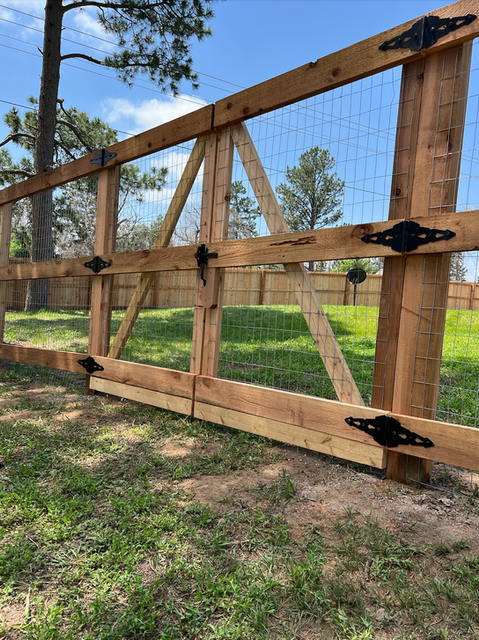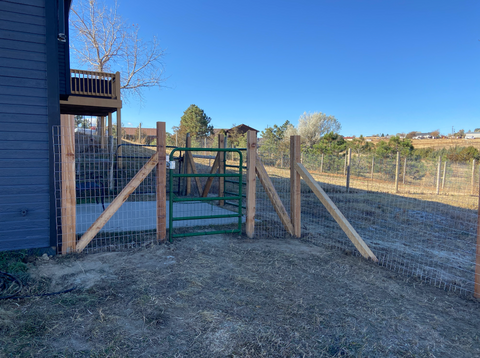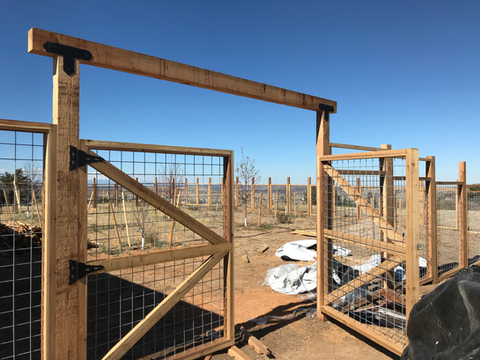
Solutions
Whether it's adding some privacy, making your backyard safe for kids or a pet, or whether your are just looking to keep out the deer, the chances are you're looking for a fence because you need a solution to a problem.
While your problem may be entirely different, looking at solutions we've done in the past can be a great place to start.
Protecting Gardens
There are generally four things to keep in mind when looking to protect your garden:
1) Identify the Goal: The first step is to identify what you're trying to protect your garden from. This will help narrow down the size of the fence and whether you need netting on top. Common critters to consider include deer, rabbits, dogs, livestock, wild birds, etc.
2) Maximize Sunlight: While you want to stop things from getting into your garden, you don't want to accidentally block the sunlight. To address this, most people opt for a wire fence.
3) Consider Costs: Generally, more materials mean higher costs. However, sometimes it's necessary to add more materials to make a fence sturdier, last longer, or be more aesthetically pleasing.
4) Remember Gate Size: Do you plan on needing a tractor someday, or will you need to bring in a truckload of dirt? The answer to questions like this will help determine how big the gates need to be.
5) Consider Birds: One often overlooked aspect is whether you want to prevent birds from accessing your garden. For many gardens this is unnecessary, however, if you are growing something particularly sought after by birds you may want to consider adding an extra layer of protection over your garden.
Securing Dogs
Here are some things to consider as you look to keep man's best friend safe and secure:
1) Identify the Goal: The first step is to identify what you're trying to achieve. For example, if your dog is vulnerable to predators, you may be more concerned about keeping things out than preventing your dog from escaping. On the other hand, if you have an escape artist, you'll want a fence that effectively prevents them from getting out.
2) Consider Size: The answers to the previous question will help you determine the appropriate height for your fence.
3) Consider Wire: You will likely want to incorporate wire into the fence to prevent your pup from escaping through it. Consider the size and strength of the wire. A small dog might squeeze through a larger wire fence, while a larger, more determined dog might bite through weak wire.
4) Consider Cost: Some opt for a minimalistic fence to keep costs low, while others might add more materials to make the fence sturdier.
5) Consider Options: We offer various options for designing a fence for dogs. These include dog windows to reduce barking, dog kennels with wire roofs for added security, and electric fences at the top to prevent climbing. Share your concerns with us, and we can help identify the best solutions for your needs.
Gates
Here are some things to consider as you consider what type of gate you will need:
1) Identify the Goal: What will need to fit through the gate? A lawn tractor? A camper? Spend some time thinking about everything that will need to be able to fit through the gate.
2) Consider Size: The answers to the previous question will help you determine the appropriate width for your gate
3) Consider Style: Gates are a great opportunity to add a bit of stylistic elements to your fence. Check out some of our previous work below to help get ideas.
4) Single or Double: If you need an extra wide gate it often makes sense to do two separate gates. This ensures the gate doesn't sag from the weight.
5) Go With A Pro: Before you decide on a contractor you should look at their previous work, paying extra close attention to the gate they built. Here are some things you want to look for:
-
Make sure that the reveal is even. If you can already tell it's not even then it will only get worse with time.
-
Make sure the post with the hinge is sturdy and has some extra concrete.
-
Make sure the gate opens all the way. Some contractors will make silly mistake like opening the gate in the direction of a hill... the result is a shoddy gate that won't open.
-
Look for a gate brace. There can be quite a lot of weight on a gate, so you want to make sure that there is a brace and that it is going the correct direction.


















































